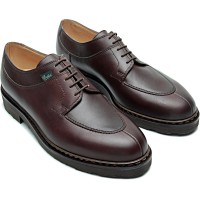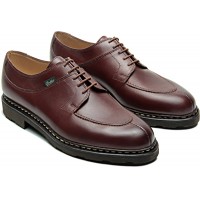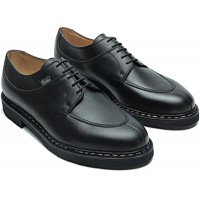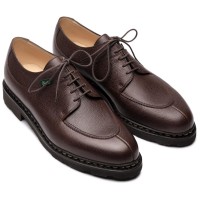Paraboot Avignon Shoes
The Paraboot AVignon names after the prefecture in France is a split toe derby shoe. The origins of the style can be traced back to the early 20th century when Norwegian fishermen needed sturdy and reliable footwear for their demanding work. These shoes were crafted by hand, using techniques that allowed for increased durability and protection against the harsh weather conditions. The split toe design was not only visually appealing but also served a functional purpose by providing added reinforcement to the toe area, making the shoes more resilient.
In the 1930s, the split toe derby gained popularity as a stylish and durable option for everyday wear. The design's distinctive aesthetics and practicality caught the attention of fashionable men in Europe and the United States, leading to its widespread adoption as a dress shoe.
One of the most significant moments in the history of the split toe derby shoe came in the 1970s when it was introduced in France. The refined craftsmanship and attention to detail helped elevate the split toe derby to a new level of prestige and so has became highly sought after as a benchmark for quality and style in the world of men's footwear.
It has become a staple in both formal and casual wardrobes, bridging the gap between tradition and modernity.
The Paraboot Avignon has a Norwegian welted construction. Here is why
The Norwegian shoe welt, also known as the Norvegese construction or Norwegian welt, is a type of shoe construction that offers several advantages. Here are some of the key advantages of the Norwegian shoe welt:
- Durability: The Norwegian welt is known for its exceptional durability. It involves stitching the upper leather directly to the midsole and outsole, creating a robust and long-lasting bond. This construction method ensures that the shoe can withstand heavy use and provides excellent resistance to wear and tear.
- Water Resistance: One of the notable advantages of the Norwegian shoe welt is its superior water resistance. The welt itself acts as a barrier, preventing water from seeping into the shoe through the stitching. Additionally, the stitching technique used in this construction method makes it difficult for water to penetrate, keeping your feet dry even in wet conditions.
- Repairability: Norwegian-welted shoes are highly repairable. The construction allows for easy resoling, as the stitching is visible on the outside of the shoe. When the sole wears out, it can be removed and replaced without affecting the upper part of the shoe. This feature enhances the longevity of Norwegian-welted footwear and makes it a cost-effective choice in the long run.
- Flexibility: Despite its robust construction, Norwegian-welted shoes offer good flexibility. The visible stitching along the sole allows for greater movement and natural flexing of the shoe, providing comfort and ease of wear.
- Aesthetic Appeal: The Norwegian shoe welt is often admired for its distinctive and attractive appearance. The visible double stitching on the welt adds a unique touch to the shoe's design, contributing to its overall aesthetic appeal.
- Insulation: The Norwegian welt construction can provide enhanced insulation properties. The double layer of stitching and the welt itself can act as an additional barrier against cold temperatures, helping to keep your feet warm in chilly weather.
Although Norwegian-welted shoes are typically more expensive than shoes constructed with other methods due to the craftsmanship involved. However, the advantages mentioned above, especially the durability and repairability, make them a worthwhile investment for those seeking high-quality footwear.
Featured
Paraboot Avignon/Griff Lis Cafe Mens Lace Up Shoes
Split toe derby with 5 eyelets.Leather lining, genuine Norwegian welted on genuine rubber sole shoes..
£385.00 Ex Tax: £320.83
Paraboot Avignon/Griff Lis Marron Mens Lace Up Shoes
Split toe derby, 5 eyelets.Leather lining, genuine Norwegian welted on genuine rubber sole shoes...
£385.00 Ex Tax: £320.83
Paraboot Avignon/Griff Lis Noir Black Mens Lace Up Shoes
Split toe derby, 5 eyelets.Leather lining, genuine Norwegian welted on genuine rubber sole shoes...
£385.00 Ex Tax: £320.83
Paraboot Avignon/Griff Moka Grain Mens Lace Up Shoes
Split toe derby with 5 eyelets.Leather lining, genuine Norwegian welted on genuine rubber sole shoes..
£385.00 Ex Tax: £320.83




